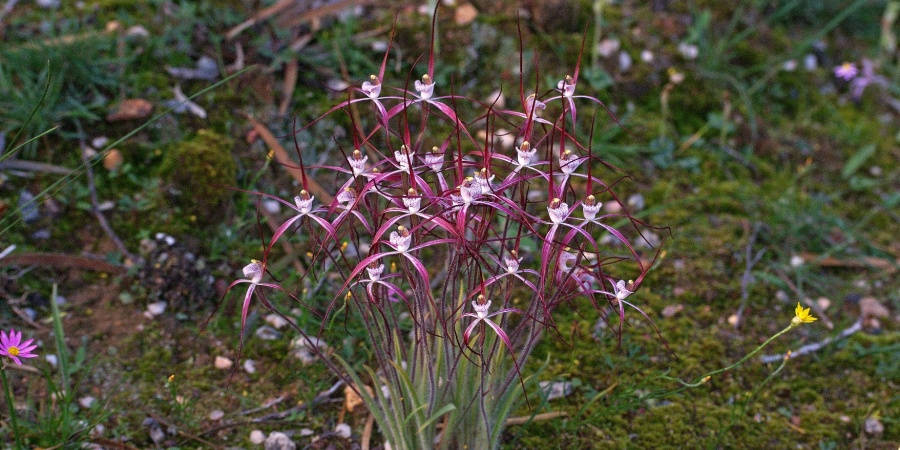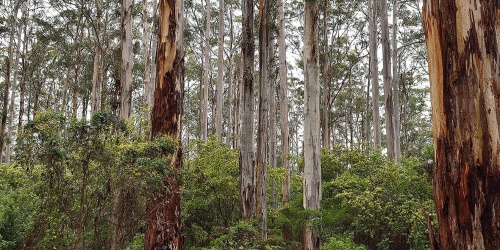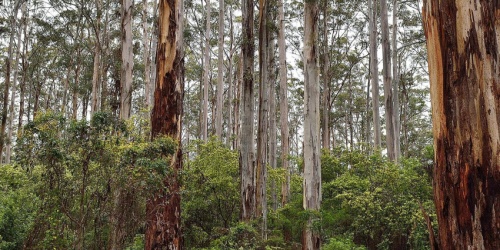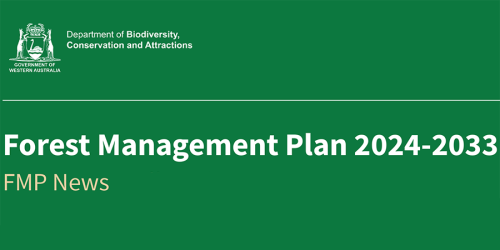
Caladenia denticulata subsp rubella (Clumped Spider Orchid)
What is the forest management plan 2024-33?
Western Australia’s national parks, conservation parks, nature reserves, State forests and timber reserves are vested in the Conservation and Parks Commission and managed by the Department of Biodiversity, Conservation and Attractions under 10-year management plans developed in consultation with the community.
The Forest Management Plan 2024-2033 (FMP) provides the overall policy framework for protecting and managing forests on public lands in our south-west. It is a statutory management plan under Part V of the Conservation and Land Management Act 1984 (CALM Act). It contains a statement of policies and/or guidelines proposed to be followed and a summary of the management activities proposed to be undertaken on CALM Act lands.
The FMP planning area provides for the management of approximately 2.5 million hectares of lands in the south-west of Western Australia. The plan facilitates management of multiple values and uses of our south-west forests, including biodiversity conservation, customary practices, tourism and recreation, water, apiary and other forest-based industries.
The FMP commenced on 1 January 2024 and gives effect to the State Government decision to cease commercial native timber harvesting. Over the 10-year term of the FMP, at least 400,000 additional hectares of national parks, conservation parks and nature reserves will be created following consultation with Traditional Owners and stakeholders. Areas of State forest and timber reserves that are no longer available for native timber harvesting will be investigated for their suitability for inclusion into new or expanded conservation reserves.
Why do we need to manage our forests?
Western Australia’s south-west forests are important for biodiversity, conservation, habitat, recreation, tourism, industry, and water supply.
The south-west forests:
• are significant spiritually and for customary use by the Noongar Traditional Owners
• are important for a rich diversity of native plants and animals
• are a major recreation and tourism asset
• have rich natural and cultural heritage
• are the catchment area for most of the State’s population’s water supply, and
• support employment in a range of forest-based industries.
Read more about our forests on the DBCA website.
What are the objectives of the plan?
The FMP focuses on managing south-west forests for the protection of Noongar values, and forest health in the context of a drying and warming climate.
The four strategic goals are:
1. To value and protect Noongar cultural heritage and support Noongar Traditional Owner involvement.
2. To conserve biodiversity and support ecosystem resilience.
3. To maintain or improve forest health and enhance climate resilience.
4. To deliver social, cultural and economic benefits through the provision of goods and services.
How was the FMP developed?
The plan was prepared following wide-ranging consultation with government agencies, key stakeholders and the community. The plan is also informed by scientific research and management experience, input from technical experts and results from monitoring and evaluation processes.
The plan was developed with the consideration of legislation, government policy, community feedback, and ecologically sustainable forest management principles and criteria. The plan was assessed by the independent Environmental Protection Authority under the Environmental Protection Act 1986.
How will the plan be implemented?
The plan will be implemented using an adaptive management approach.
Adaptive management is often referred to as ‘learning by doing’ and involves several elements, including planning and design, monitoring, evaluation and reporting. Adaptive management is based on evidence and learnings, meaning that programs and activities can be adjusted if they are not successfully meeting management objectives.
The implementation of management activities will be through the State’s Forest Management System, which includes the various laws, policies, guidelines, and operational procedures for forest management.
Formal management partnerships between DBCA and Noongar Traditional Owners are an important aspect of how the plan will be implemented. These recognise the continuing connections that Noongar people have to the south-west forests and their cultural responsibilities to care for country.
Full implementation of the management activities, as documented in the plan, will require a new and significant investment in forest management and conservation. The plan has been written so that many activities are ‘scalable’; that is activities do not have to be fully implemented, or not all activities need to be implemented, depending on the desired outcomes.
For information on Western Australia’s forest management system visit the DBCA web page Managing our forests | Department of Biodiversity, Conservation and Attractions (dbca.wa.gov.au)
Is the plan now being implemented?
The FMP commenced on 1 January 2024 and is now being implemented. Further information will soon be available on initial implementation priorities, including the 2024 ecological thinning program.
An end to native forest logging
Why will logging in native forests cease?
In September 2021, the State Government announced an end to large-scale commercial timber harvesting from 2024, with provision for timber to be removed solely from management activities that improve forest health (such as ecological thinning) or clearing for approved mining operations and infrastructure. The Forest Management Plan 2024-2033 (FMP) commenced on 1 January 2024 and provides the management framework for the implementation of this forest policy.
While this decision ended large scale commercial logging operations, the FMP provides for forest management activities for forest health and resilience.
Read the State Government announcement .
Traditional owner involvement
How will traditional owners be involved in management of the south-west forests?
For the Noongar Traditional Owners, the plan is set against the background of the South West Native Title Settlement, and legislative amendments to the Aboriginal Heritage Act 1972 and the Conservation and Land Management Act 1984 (CALM Act), which offer improved protection for significant sites and Aboriginal cultural heritage.
As part of the South West Native Title Settlement, Noongar Traditional Owners and DBCA will enter into formal agreements to manage all CALM Act lands and waters in the Settlement Area (referred to as the South West Conservation Estate) together, including the south-west forests. These agreements offer recognition and support for Noongar Traditional Owners to carry out their roles and responsibilities as protectors and managers of country and culture and facilitate two-way learning to support integration of traditional knowledge with contemporary science and management practices.
DBCA is committed to consulting with Noongar representatives and will engage with the Noongar Regional Corporations when practicable. Engagement with traditional owners and Aboriginal groups will continue into the implementation of the plan.
These new cooperative and joint management partnerships mark a new era for collaboration to share Noongar and Western knowledge in managing south-west forests.
Ecological thinning
What is ecological thinning?
Ecological thinning is an active forest management tool undertaken to support forest health and resilience as the landscape continues to become drier and warmer. It involves the selective removal of individual trees to reduce water stress and improve the biodiversity of a given area.
The potential co-benefits of ecological thinning include:
- increased water availability for catchments and aquatic ecosystems
- increased resilience to drought, heatwave events, pests and bushfire
- reduced fuel loads to mitigate bushfire risk
- faster growth of remaining trees to maturity, reducing the time required to develop suitable habitat, such as hollows, for fauna
- contribution to long-term carbon storage.
Where and how is ecological thinning undertaken?
Ecological thinning is undertaken primarily in areas of densely stocked young regrowth jarrah and karri forests including some areas rehabilitated after disturbances such as mining.
While forests within the conservation reserve system and Disturbance Avoidance Zones will not generally be considered for ecological thinning in the term of the Forest Management Plan 2024-2033, the Minister for Environment may approve ecological thinning in these areas where there is a high likelihood thinning will enhance conservation outcomes. The Conservation and Parks Commission may endorse ecological thinning in Disturbance Avoidance Zones on a case-by-case basis where evaluation reports indicate thinning is likely to maintain or improve environmental outcomes.
Ecological thinning prescriptions will vary across forest ecosystems. The plan proposes an overall annual thinning program of up to 8,000 hectares per year.
Ecological thinning is currently conducted under the 2024 Indicative Ecological Thinning Plan available on the Forest Management Plan web page.
Selection of specific locations for thinning involves assessing observed and projected changes in rainfall, groundwater trends, forest condition and potential habitat for threatened species. Any proposed thinning will also need to ensure protection of the value of the land to Aboriginal cultural heritage.
DBCA is responsible for identifying candidate areas and developing ongoing guidelines and prescriptions for ecological thinning while the Forest Products Commission will provide operational support, contract management and planning.
Ecological thinning programs will be assessed through the DBCA’s Disturbance Approval System to identify and mitigate any potential detrimental impacts to the ecosystem prior to commencing.
Will the timber from ecological thinning activities be used?
While the overall scale and location of ecological thinning is driven by forest health objectives, the thinning of young regrowth stands will generate quantities of small stems which may result in excessive fire risk if left on the forest floor.
The plan provides for the salvage, removal and sale of forest products from ecological thinning operations, by the Forest Products Commission.
How will the success of ecological thinning be measured?
Under an adaptive management cycle, the effectiveness of ecological thinning operations will be assessed by monitoring programs to inform decision making for ongoing ecological thinning operations for the term of the plan. Monitoring will determine if it is working or if changes need to be made over time.
How do you respond to some claims that ecological thinning is just logging by stealth?
The State Government has committed to an end to large-scale commercial native timber harvesting and to ensuring long-term forest health through active forest management techniques, with provision for timber to be removed solely from management activities that improve forest health (such as ecological thining) or clearing for approved mining operations or infrastructure.
Ecological thinning operations support biodiversity conservation, forest health and resilience as the landscape continues to become drier and warmer in the future by targeting smaller trees in young regrowth areas, and is not required to meet a quota for forest products.
Further information on ecological thinning is available in the Independent Silviculture Review Panel Report and Ecological thinning fact sheet downloads on this page.
Other forest management activities
What other active forest management activities are included in the plan?
Apart from ecological thinning, the plan facilitates a range of active forest management programs and activities including prescribed burning, the control of pest animals and weeds, and the management of diseases such as Phytophthora dieback. Many native flora, including threatened flora species, are susceptible to this disease. Management focuses on minimising the spread of dieback and utilising new control techniques and technologies.
Fire is an important component of forest health and for ecosystem functioning. DBCA’s fire management and prescribed burning program aims to manage biodiversity at a range of scales and is supported by research and over 60 years of operational experience. In addition, the plan proposes research to investigate the impacts of fire management strategies on forest ecosystems and biodiversity for the 10-year term of the plan.
The department is committed to working with Noongar Traditional Owners to better understand, share and incorporate cultural fire knowledge.
The Western Shield program delivers fox and feral cat management to over 85 percent of the area covered by the plan and will continue to be a key approach for biodiversity conservation and maintaining forest health over the next 10 years. DBCA will also seek to identify new and innovative approaches to managing foxes, feral cats and other pest animals.
Protected areas
How much forest will be protected in conservation reserves under the plan?
The plan provides for around 320,000 hectares of existing reserve proposals to be progressed and a further 400,000 hectares of State forest and timber reserves to be incorporated into national parks, conservation parks and nature reserves.
Increasing the level of protection for an additional 400,000 hectares will involve consideration of changing State forest and timber reserves to other formal conservation reserve categories (i.e. national and conservation parks and nature reserves).
The plan provides for a process to refine the boundaries of State forest and timber reserves in consultation with traditional owners and stakeholders, including the resources sector, conservation groups, local government and other parties.
Why are there still over 300,000 hectares of proposed reserves from previous plans that have not been created yet?
The proposed reserves have not been progressed mainly due to the South West Native Title Settlement not being resolved, identified mineral resources and mineral prospectivity, and the rights of State Agreement Act mining lessees. Since 2019, commitments for the reservation of lands and waters elsewhere in the State, through the State Government’s Plan for Our Parks initiative, have also been a high priority for the Commission and DBCA.
Under the plan, areas proposed for inclusion in the reserve system will be managed consistent with their proposed land category and purpose.
Firewood
Does the plan allow for the collection of firewood?
Firewood is made legally available by DBCA through public firewood collection areas in State forest, and will remain commercially available. Commercial firewood will be sourced from salvage of timber following clearing from approved mining operations and infrastructure and forest management activities that improve forest health.
Firewood cannot be taken from national parks, nature reserves or conservation parks. It’s important to note that firewood should not be taken from other non-CALM Act (Conservation and Land Management Act 1984 ) public lands, or private property, without permission.
The plan provides for the development of a Public Firewood Management Strategy to address broader issues associated with demand for firewood and how this could be addressed over time.
Climate change
What is the impact of climate change on the south-west forests?
Climate change and its impacts on rainfall in the south-west, and the decline in rainfall since the 1970s has been deemed greater in the south-west than anywhere else in Australia.
Information on climate change in Western Australia is available at the following website: Western Australia climate projections: Summary
Fire management
How will fire be managed under the plan?
Fire seasons are becoming longer and more intense due to the impacts of climate change. In the south-west, the decline in rainfall since the 1970s has been greater than anywhere else in Australia. As a result, the south-west landscape is dry and is remaining drier for longer periods, which influences the flammability of forest vegetation. This places an even greater importance on bushfire mitigation.
The department has a legislated responsibility under the Conservation and Land Management Act 1984 to prevent, manage and control fire on lands to which this Act applies. As part of the plan, DBCA will continue to be responsible for the management of fire in south-west forests, parks, nature reserves and other lands that it manages, including managing fuel loads through planned burning.
Management of forest roads, firebreaks and fire access tracks under the plan will assist in maintaining capability in fire management.
Basic raw materials
What are basic raw materials?
State forest and timber reserves contain supplies of gravel, shale, clay, sand, limestone and rock that together are known as basic raw materials (BRM).
These materials are used for road making and building throughout the south-west, and those from State forest and timber reserves are provided to government agencies and local governments through leases issued under section 97 of the Conservation and Land Management Act 1984.
DBCA also uses BRM for building and managing recreation sites and other essential management activities.
Apiary
What is an apiary site?
Honey (and related products such as bee pollen, bees wax and royal jelly) is collected by apiarists who access areas covered by the plan using a system of designated apiary sites registered with DBCA.
DBCA manages and issues apiary permits and licences in accordance with Part 8A – Apiary permits and licences of the Conservation and Land Management Regulations 2002. These may be issued for periods of up to seven years and can be transferred between apiarists.
Land that DBCA can issue apiary permits or licences for includes national parks, conservation parks, nature reserves, state forest, timber reserves, pastoral leases, mining tenements and unallocated Crown land.
Learn more about beekeeping on Crown Land on the DBCA website.
Mining
Mining activities are primarily approved and governed by processes managed by other government agencies under legislation such as the Environmental Protection Act 1986, Mining Act 1978, Petroleum and Geothermal Energy Resources Act 1967 and various State Agreement Acts.
Mining operations are not approved under the Conservation and Land Management Act 1984 and do not rely on forest management practices or the forest management plan to occur.
Was the plan assessed by the EPA?
The Draft Forest Management Plan 2024-2033 (the plan) was referred to the Environmental Protection Authority (EPA) for a determination on whether the plan required assessment under Part IV of the Environmental Protection Act 1986 (EP Act).
In late May 2023, the EPA determined to assess the plan at the level of Assessment on Referral Information (with additional information). The EPA also decided to undertake targeted consultation with relevant stakeholders and groups as part of the assessment.
The EPA released its assessment report in August 2023, recommending the plan may be implemented subject to conditions outlined. On 30 November 2023 the Minister for Environment approved the implementation of the plan subject to implementation conditions and procedures outlined in the Ministerial statement.
All documents provided to the EPA; the EPA assessment report; and Ministerial statement that a plan may be implemented are available on the EPA website.
Can I access references listed in the plan?
Yes, titles in the FMP 2024-2033 reference list can be accessed via the DBCA Library online catalogue via library.dbca.wa.gov.au.
You can search by author, title, browse the Draft Forest Management Plan 2024-2033 reference list or access the list of titles through Quick Links - FMP References.
Most documents are available in full text, or copies can be provided on request. To request a title, email library@dbca.wa.gov.au or click on the request icon from the record you are in.
The DBCA Library is open to the public Monday to Friday between 8.30am and 4.30pm.
Where to find the DBCA Library
17 Dick Perry Avenue, Technology Park, Western Precinct, Kensington
Email: library@dbca.wa.gov.au
Phone: 9219 9058


